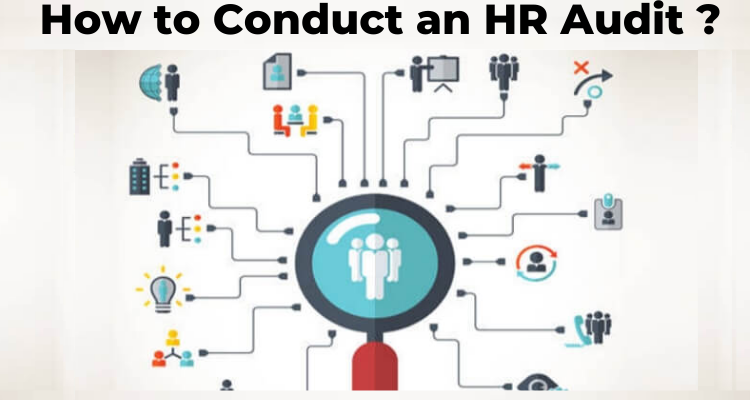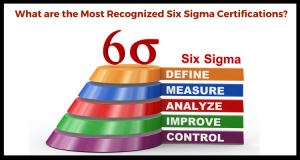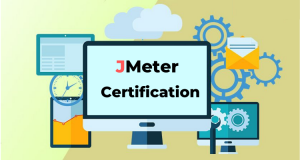Do you want to learn about conducting an HR audit or want to know about various strategies and ways to conduct it? Then you are at the right place. In this article, you will learn about the auditing strategy and practices to check department’s adequacy, effectiveness,and making it problem-free.
Human resources audits have to focus on every human resource function. And, this includes recruitment and selection, workplace safety and risk management, training and development, employee relations, and compensation and benefits. However, your primary purpose of auditing is to check if the organization’s policies are current. And, also if they are following federal and state laws as described. Most importantly, without regular audits, the company may get affected by decreased efficiency, unhappy employees and lawsuits.
So, to better understand this, let us move towards learning more about HR audit together with factors affecting it. Moreover, you will also learn different ways and strategies to conduct an audit. So, just keep up with the article and learn all the skills to become an HR Auditor.
Overview of HR Auditing
In general, HR audit helps in reviewing the HR department’s specific practice areas or processes that are adequate, legal and effective. Further, the process of HR audit is to review as well as spot gaps in HR practices. Moreover, as an HR you will be required to puts efforts to minimize these gaps to achieve and maintain world-class competitiveness in the practice areas.
Basically, auditing is about giving time and effort for taking look at the organization’s HR policies, practices, and strategies for identifying opportunities for improvement. This can help the decision-makers to get the information necessary to decide which areas need improvement. Moreover, as an HR auditor, you will be required to perform the following tasks –
- Firstly, you will be responsible for the evaluation of the organization’s operational HR policies, practices, and processes.
- Secondly, you will responsible to perform a review of current HR indicators
HR Auditing Types
There are several types of audits, and each is designed to achieve different objectives. Some of the more common types are –

- First is Compliance. In this, there is a focus on how well the organization is following with current federal, state, and local laws and regulations.
- Next is Best practices. It helps the organization to maintain a competitive advantage by comparing its practices with those of companies.
- Third, is Strategic. This focuses on strong and weak areas of systems and then processes it to determine whether they align with the HR departments.
- Last is Function-specific. It focuses on a specific area in the HR function.
HR Audit: Need for an Organization
Human resource audits are required for avoiding legal and regulatory liability that may arise from an organization’s HR policies and practices. Moreover, it involves identifying issues and finding solutions to problems before they become difficult to manage. As a result, this will help to assess if an organization is doing right, as well as how things might be done more efficiently or at a reduced cost.
In an organization, the HR performance audit reviews the personnel files with the aim of evaluating the quality of feedback for managers by the staff. Moreover, there can also be a function-specific audit that is a kind of mini-review, where there is the validation of just one area of HR processes or policies.
We shall now move forward to discuss what, when and who to audit including other essential factors of auditing.
Basics Operations in HR Audit
For audit conduct, there are different areas where you have to keep an eye on. Moreover, knowing about these will help you create strategies and practices for your organizations. So, first, let’s start with,
What to Audit?
Deciding what to audit rely on the weaknesses in the organization’s HR environment, the auditing types and the available resources. However, keeping issues records that have been identified can help in recognizing areas of potential exposure that HR can address during the annual review process.
However, the organizations are particularly at risk in certain areas. There are some additional risk areas that require careful review in an audit. It includes:
- Firstly, there can be misclassification of exempt and nonexempt jobs. As in every organization, there are job positions that have been misclassified as exempt from overtime eligibility.
- Secondly, there can be inadequacy in personnel files. That is to say, a review of sample personnel files often reveals inadequate documentation of performance.
- After that, there are prohibited attendance policies. It means controlling excessive absenteeism is a big concern for most employers.
- Then, inaccurate time records. Most employers require nonexempt employees to complete timesheets reflecting their time worked each week.
- Lastly, the form I-9 errors. In this, there are reviews of employer hiring practices that uncover inadequate documentation.
When to Audit?
For a full-scale audit, resources are required and most of the organizations do not want to go through this process for more than once a year. But, there are mini-audits that let some course correction which can be achieved without too much departmental pain approximately every six months. Moreover, it is preferred to schedule annual check-ups to maintain the discipline of a regular review.
What to Expect?
A Complete audit takes a lot of time to complete the process. This requires the review of many documents and policies, as well as feedback from HR staff, selected employees and managers from other departments. However, the amount of time and the effort required are dependent on,
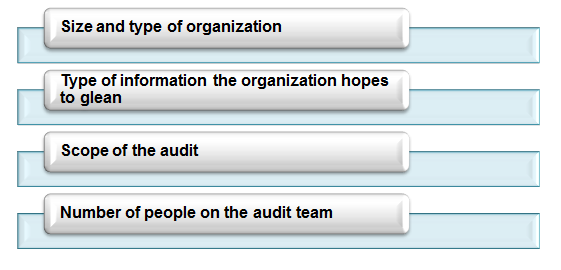
Costs of an Audit
The cost of auditing depends on the scope of the review, the number of people interviewed and the size of the audit team. Therefore, the expense ranges from one situation to another. However, some insurance carriers even provide audits as a part of their compliance programs, so it could actually be free.
Who Should Conduct an Audit?
The Certified HR Audit Professionals can perform an audit, using their expert-level knowledge, time, a desire to objectively acknowledge insufficiency in current procedures. Most importantly, they have the power to make or influence the necessary organizational changes. However, if the audit is done using internal resources or with an outside consultant then, everything linked with the audit is subject to discovery in litigation relating to employment practices.
If anyhow organization has legal concerns about what auditing may reveal during the process regarding the company’s various employment laws and regulations. Then, the organization should follow audit procedures and then consider hiring outside legal counsel.
Now coming on to the process of conducting an audit.
Process of Conducting Audit
The process of conducting an audit includes seven steps. These are,
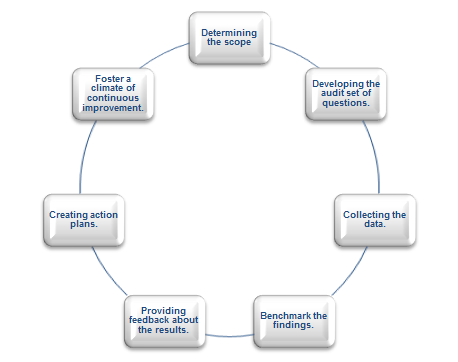
Step 1 – Determining the scope
To discover the required information, the audit team should determine the target areas for review. However, if the organization has never done auditing for its HR function then, the audit team may conduct a full-scale review of all HR practice areas. On the other hand, if concerns are limited to a specific process or policy then, the audit team can focus its review on that particular area.
Step 2 – Developing the audit set of questions
Whether conducting a full-scale audit or an audit for a specific practice, the audit team has to invest enough time in developing a complete document to obtain information on all the subjects of the inquiry. Moreover, HR must create a list of specific questions to ensure that the questionnaire is complete.
Step 3 – Collecting the data
This phase includes the actual process of reviewing specific areas to collect the data about the organization including its HR practices. And, the Audit team members will use the audit questionnaire as a road map to review the specific areas that are identified within the scope of the audit.
Step 4 – Benchmark the findings
To assess the audit findings, the team must compare them with HR guidelines. Moreover, this comparison will help to know how the audit results are compared against other similarly sized firms, national standards or internal organizational data. And, the information which is internally benchmarked includes,
- Firstly, the organization’s ratio of total employees to HR professionals.
- Secondly, the ratio of dollars spent on HR function relative to total sales,
- Thirdly, general and administrative costs.
- Lastly, the cost per new employee hired.
Step 5 – Providing feedback about the results
In the end, the audit team recaps the data and provides feedback to the HR professionals and senior management team in the form of findings. Moreover, from this final analysis, the audit team can create a timeline for action that will help in finding the order to address the issues raised. And, the audit team should also discuss the results of the audit with employees in the HR department, as well as with the senior management team, to make them aware of necessary changes.
Step 6 – Creating action plans
It is serious that the organization should do something with the information identified as a result of an audit. That is to say, the organization must develop action plans for implementing the changes suggested by the audit. However, conducting an audit and then failing to act on the results can result in increased legal risk.
Step 7 – Continuous Improvement of Audit
Lastly, the HR leaders must involve the observation and continuous improvement of the organization’s policies, procedures, and practices. So, the organization never stops improving. And, this will ensure that the company achieves and retains its competitive advantage. This includes two approaches,
- Firstly, to continuously monitor the HR systems to ensure that they are up-to-date and to have follow-up mechanisms.
- Secondly, to designate someone on staff for monitoring legal developments.
Helpful Resources for HR Audit
As mentioned above, there are various steps that will help you with audit conduct. And, this requires a good understanding and hands-on knowledge in the auditing. So, for this one needs to be professionally experienced in this field. In other words, there are various training providers that can help you get advanced in the Human Resource field by providing certifications. Some of the top providers include Vskills – India’s largest certification body, AIHR Academy, SHRM, etc. Moreover, here you will learn about various areas of auditing as well as other beneficial parts of it. And, to prepare for this it will require a lot of hard work and practicing questions for HR Audit Professional.
Summing up
Every organization wants to check if the department is adequate, effective, problem-free and most importantly, legal. And, for this auditing is done to identify issues, growth areas or declining problem spots to help in the decision allocating time, money and preventive training resources in the future. Moreover, auditing can help in improving the department’s image and contribution to the company. So, getting into this can help you a lot in having a bright future and a good career.
Learn and enhance your HR Auditing skills. Become a Certified HR Audit Professional Now!

